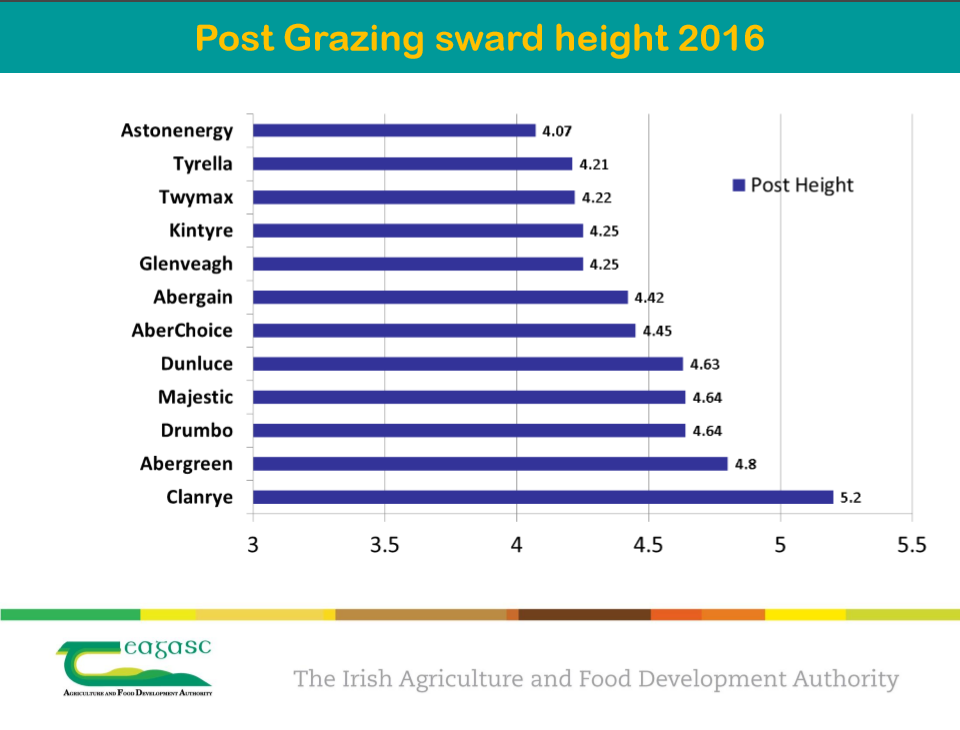Traditionally, grass varieties have been selected on the basis of high digestibility, to drive animal performance, and high dry matter production to enable high stocking rates to be carried.
However, there is an increasing demand for varieties that are most suited to grazing. Such varieties can be cleaned out easily and do not require the extra time and cost of topping; these characteristics drive animal performance at each grazing in the rotation.
Ultimately, this means varieties that don’t need mechanical intervention, varieties that are grazed more often, create extra milk and meat to leave more profit in the farmer’s pocket.
Unfortunately, to date, this kind of grazing information is not included in the Pasture Profit Index (PPI).
The PPI is only derived from cutting trials conducted by the Department of Agriculture; so no animal effects are currently factored into the PPI.
New grazing trials
Thankfully, this kind of information is now streaming in from Teagasc’s on-farm grass variety evaluation study.
In this experiment, varieties are being sown on commercial farms across the country and are subjected to all the rigours of actual grazing pressure that swards experience on normal Irish farms.
Furthermore, the variety’s performance with regard to yield, digestibility under grazing, number of grazings and post-grazing sward height are all measured.
Of course management plays a massive part as well. It’s essential to have the correct soil fertility and pH. In addition, grazing covers at less than 1,500kg/ha will improve graze out.
Results
Figure one (below) shows the post-grazing sward height of all the varieties tested. When it comes to easy-care varieties, AstonEnergy comes to the top of the pile.
AstonEnergy was grazed to the lowest post-grazing sward height (4.07cm) of all the varieties tested; meaning that more of the grown grass was turned into meat or milk and the sward can regrow from a clean starting point without topping.
AstonEnergy also achieves the most grazings along with one of the best results for digestibility, spring growth and total growth over the four-year period of 2013 to 2016.
This is in slight contrast to the spring growth figure on the PPI. Of course the findings reported from grazing swards are likely to be most applicable to Irish farms.
Dr. Patrick Cashman, Grass and Forage Development Manager at Goldcrop, said: “AstonEnergy is being grazed more often; producing high yields of highly-digestible grass; being grazed clean every grazing; and ultimately leaving more money in the farmer’s pocket.
When you look across all the important traits, AstonEnergy really does tick all the boxes
“There is a distinct advantage in having a variety that is grazed clean easily. Cows are put under less pressure to clean out a paddock and the resulting material in the following rotation is of really high quality.
“While AstonEnergy looks good on the PPI, where it really excels is under actual animal grazing,” he said.
What kind of mixture?
AstonEnergy creates a sward with low density. To combat this it’s recommended to mix AstonEnergy with a dense diploid variety.
Alfonso is also a denser alternative to AstonEnergy, with similarly strong digestibility as it comes from the same breeder as AstonEnergy.
In addition, mixtures with 50% AstonEnergy, accompanied by Glenveagh and Majestic, have been getting extremely positive feedback for dry matter performance, graze out and animal preference. Click here for more information


